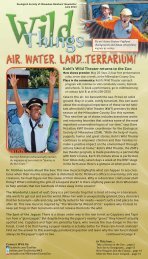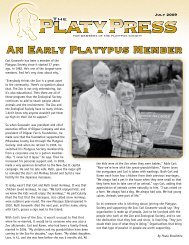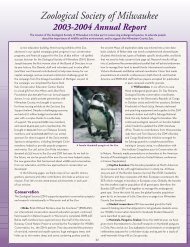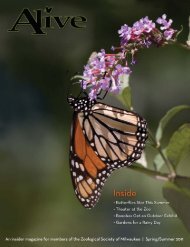AliveFall 2005 - Zoological Society of Milwaukee
AliveFall 2005 - Zoological Society of Milwaukee
AliveFall 2005 - Zoological Society of Milwaukee
You also want an ePaper? Increase the reach of your titles
YUMPU automatically turns print PDFs into web optimized ePapers that Google loves.
A big male approaches cautiously, peeking through<br />
the branches, and then settles down on a large limb.<br />
To everyone’s surprise, the bonobos do not flee;<br />
they stay where they are. Eventually, team members<br />
begin speaking in normal voices. The humans move<br />
about freely on the forest floor below the great apes.<br />
Still the bonobos do not flee. At the base <strong>of</strong> a tree lies<br />
the body <strong>of</strong> a dead infant bonobo. If an infant dies,<br />
sometimes the mother will guard the dead baby for<br />
a while, Dr. Reinartz says. She speculates that the<br />
bonobos may resist their impulse to run away because<br />
<strong>of</strong> the dead infant. For whatever reason, the primates<br />
are close enough to photograph, a rare occurrence.<br />
Getting pictures, aiming straight up at a subject that<br />
is black against the bright sun, is a challenge, but<br />
this time it’s possible.<br />
Mboyo Bolinga is exceptionally eager for<br />
Nathaniel to take a picture. He impatiently shakes<br />
Nathaniel as he tries to focus the camera: “Take the<br />
picture! Take the picture!” Nathaniel eventually does.<br />
“The men see bonobos much more frequently than<br />
I do,” Dr. Reinartz says <strong>of</strong> her Congolese colleagues,<br />
“but because we have a camera they are so excited they<br />
can barely speak. They’re from this area and live here.<br />
They have a lot more invested in this conservation<br />
effort than we do. They put their lives on the line<br />
every day to protect the forest against<br />
animal poachers.”<br />
Nevertheless, Dr. Reinartz wonders<br />
at the jubilant reaction over this last<br />
encounter. Observing bonobos is an<br />
exceptional experience for her, but why<br />
are the Etate locals so thrilled? “You see<br />
bonobos all the time,” she tells Mboyo<br />
Bolinga. “Why are you so excited?”<br />
Mboyo Bolinga has seen the photographs<br />
Reinartz takes in the copies <strong>of</strong> Alive that she brings<br />
to the station on her missions. He knows that the<br />
magazine represents the <strong>Zoological</strong> <strong>Society</strong>,<br />
which established the research station and<br />
keeps it going. He replies, “Madame, you’re<br />
going to tell the world that there are<br />
bonobos at Etate.”<br />
Dr. Reinartz responds, “That’s exactly<br />
what I’m going to do.”<br />
-By Jo Sandin<br />
A male bonobo looks<br />
down on the <strong>Zoological</strong><br />
<strong>Society</strong> researchers.<br />
Photos: ZSM<br />
Right: This clear photo <strong>of</strong> a bonobo was<br />
possible because the ape is in the Lola ya<br />
Bonobo sanctuary in Kinshasa, the capital<br />
<strong>of</strong> the Democratic Republic <strong>of</strong> Congo.<br />
Peeking through<br />
the treetops.<br />
A baby<br />
bonobo<br />
clings to the<br />
trees.<br />
ALIVE FALL <strong>2005</strong> 23













